Major earthquakes in Turkey and Syria on Monday that killed more than 11,000 people have left a trail of destruction in their wake, with several historic buildings and landmarks suffering severe damage, according to local media reports.
Monday’s 7.8-magnitude quake and 7.6-magnitude temblor that followed caused damage to several World Heritage sites, UNESCO has said. In addition to damage to the Old City of Aleppo in Syria and the fortress in the southeastern Turkish city of Diyarbakır, at least three other World Heritage sites may have been affected, according to UNESCO.
Part of the ancient wall of #Antioch Gate in #Aleppo Old City was collapsed due to the earthquake pic.twitter.com/PlxbzjLkLB
— Ibrahim Muhammad (@IbrahimDSY1) February 6, 2023
The famous Neolithic site of Göbekli Tepe in Şanlıurfa province, which is home to 10,000-year-old megaliths, the world’s oldest; Nemrut Dağ, one of Turkey’s most iconic attractions due to huge statues that are part of an ancient royal tomb built high on a mountain; and the Neo-Hittite archeological site of Arslantepe outside Malatya, a city that was also severely affected by the earthquakes, are sites of concern to UNESCO.
@Graham__Hancock @randallwcarlson @joerogan
Göbekli Tepe is 2hrs and 5 minutes from Gaziantep. 106 miles/ 170km. The epicenter of the 7.8 mag earthquake was just 21 miles/34km West of Gaziantep. Plus hundreds of aftershocks. 😞😳😞I'm afraid to think of the consequences. pic.twitter.com/oohUmshmbB
— JonesZ (@eurekagraphic_d) February 8, 2023
The destruction is not limited to World Heritage sites. The earthquakes damaged or partially destroyed historic sites such as Gaziantep Castle.
Gaziantep castle, constructed by the Romans and rebuilt extensively by the Seljuks, collapsed. #deprem #TurkeyEarthquake pic.twitter.com/0JRUIUj2tV
— Liz Cookman (@liz_cookman) February 6, 2023
The castle, dating to the second century AD, in the center of the Turkish city of Gaziantep was partially destroyed, with many of its walls and watchtowers leveled and other parts damaged.
The 17th century Şirvani Mosque in Gaziantep was also partially destroyed. The mosque, one of the oldest in Gaziantep, saw its eastern wall and dome collapse in the quake.
Also from 2011, the 17th Century Şirvani Mosque in downtown Antep. Reports are that the dome and eastern wall have crumbled. pic.twitter.com/lnX62UqimY
— James Ryan (@jdryan08) February 6, 2023
The earthquake also destroyed the minaret of the 18th-century Karagöz Mosque in the city as well as the west wall of a centuries-old hotel called Bayaz Han.
Depremin vurduğu tarihi Bayazhan batı duvarı.
Gaziantep pic.twitter.com/UoizHMYYlp— Yorgun Adam (@Yorgun_Adam112) February 7, 2023
The quakes also damaged the Grand Mosques of Kahramanmaraş, Adıyaman and Şanlıurfa, which all bear the same name and date back to the 15th-16th centuries.
The dome of the 17th-century Yeni Mosque in the city of Malatya collapsed in the recent earthquakes. This mosque has long been hit by earthquakes, destroyed in an 1894 quake and damaged by one in 1964.
Malatya's Teze (Yeni) Mosque, before and after today's devastating earthquake in Turkey
📷: @nytimes pic.twitter.com/dLPC5gaY4m— Soner Cagaptay (@SonerCagaptay) February 6, 2023
In the Antakya and İskenderun districts in the southern province of Hatay, the quakes destroyed or damaged several historic churches. St. Paul Orthodox Church in Antakya collapsed, with the facade appearing to be destroyed. In İskenderun, the Cathedral of the Annunciation, also known as the Alexandrian Catholic Church, was also significantly damaged.
🇹🇷 A historic Greek Orthodox church in Antakya (formerly Antioch) was severely damaged by the earthquake that struck Turkey and Syria.
Sursa : @European_Insider pic.twitter.com/zuQLqJ6qjD
— Scarlett Mary 🇷🇴 (@ScarlettMary13) February 6, 2023
The Antakya Synagogue, built in 1890 in southern Turkey, was damaged in the earthquakes that devastated the country on Monday.
Saving ancient Torah scrolls from the earthquake damaged synagogue of Antakya – home for a Jewish community for 2500 years… #antakyadeprem pic.twitter.com/ZsHzVKdHWZ
— Rabbi Mendy Chitrik (@mchitrik) February 7, 2023
Rabbi Mendy Chitrik, who heads the Alliance of Rabbis in Islamic States based in İstanbul, recovered Torah scrolls from the synagogue. “The walls have cracks,” he said in a telephone interview with Haaretz about the synagogue, which was built in 1890.
The synagogue served the few remaining members of the ancient city’s once-thriving, 2,300-year-old Jewish community — now made up mostly of descendants of Syrian Jews, which by the 2010s had dwindled to fewer than 20 members.

